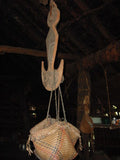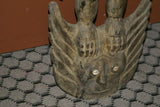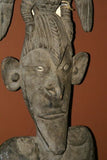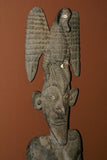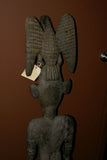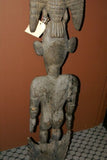SOLD: Papua New Guinea Unique 4FT Suspension Hook Hand Carved Iatmul Tribe Sepik 30A7
SOLD: Unique 4 ft Hand-carved Suspension Hook
Item 30A7 in our inventory
All our Tribal Sepik river carvings from Papua New Guinea were collected on the premises.
Large Oceanic Sepik Ancestor Spirit Figure to accommodate benevolent spirits Measures: 4 ft tall X 11" X 4"
Weighs:10 lbs
Used as a Suspension Hook or Bara Kundambuk
From the Iatmul Tribe
Collected more than 20 years ago in Kandingai (kandigai) Village, Upper Sepik River region, Papua New Guinea
This suspension large Hook Statue was hand carved out of local wood with eyes of inserted shells. Animal forms are often incorporated into the carvings, in this case the main figure of the ancestor has feet that turn into claws as the eagle on its head, which is the bird symbol of the clan, and supporting the Ancestor’s claw feet is the face of a protective ancestor as well. The main figure is part man, part beast. Some initiation scarification tattoos are seen on the belly. Hooks are used along the Sepik as the rest of PNG for both secular and ceremonial purposes. They are suspended in the men´s house and in individual houses to hang valuables or ritual items as seen on photo 2. They each belonged to individual clans.
Photo 2 shows a hook hanging in a house on the Sepik, that we took while there.
Food hooks are used functionally to preserve food: Food goods are hung from the hook in bilums (woven bags) to keep it safe from rats and mice. Suspending food from the food hook discourages vermin, and the spirit thought to inhabit the hook is believed to retard spoilage.
In the houses, Bilum bags filled with food and possessions were hung from such Food Hooks to keep necessities off the floor, out of the way of children, dogs and vermin, especially during the wet season as the land became inundated and rats moved from the bush into the roof thatching (called Marota). At this time of year, food is scarce and the rats will eat anything. For protection, the food is then placed in baskets or string bags (called bilums) and hung from these hooks.
The basket hook is attached to the rafters with a length of split cane (Kanda) and a wide, flat piece of bark is threaded onto the cane to prevent the rats from climbing down from the rafters to the food.
Cult hooks, food hooks and skull hooks/racks have evolved artistically over hundreds of years, with each village or district developing its own distinct style. The artistic development of hooks has sometimes overtaken their functionality to the point where some samples of this genre no longer have any notches to 'hook' things on.
We go straight to the source to find these treasures.
All our collector and rare items come with pages and pages of research about provenance, and with history of the tribes and photos as well, depending on item and whenever possible. When shipping internationally, we group ship multiple purchases to save you money, and find the best rates available.













